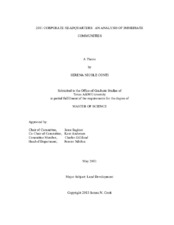| dc.description.abstract | While the Bay Area’s history has shaped today’s culture, there is little written about how corporations affect their immediate communities. This thesis focuses on the largest corporations in the Bay Area to determine if these corporations have any effect on the surrounding communities.
The study focuses on Fortune 500’s list of Largest Corporations for 2011, and within that list, the top 30 companies located in the nine Bay Area counties. These nine counties include: Alameda County, Contra Costa County, Marin County, Napa Country, San Francisco County, San Mateo County, Santa Clara County, Solano Country, and Sonoma County.
Using each corporations’ headquarter address as the reference point, a 1-mile radius surrounding each of the 30 companies was assessed. Data was gathered for the years 2000, 2010, and projected 2015. These data are available via ESRI’s Business Analyst Online application, which is accessible through the Texas A&M University Library’s website.
Demographic information such as population, income, education, and related characteristics were reviewed. To understand the population’s lifestyle and possible implications for real estate development opportunities, the study reviewed the local demographic spending patterns, what these people do for recreation, their occupations, whether they rent or own their home, how they travel to work and their commute times, and other lifestyle variables. There were 40 variables tested and 53-percent of those variables produced statistically significant results. While the Demographic variable yielded a 56-percent statistical significance rate and the Consumer Spending variable yielded a 43-percent statistical significance rate, the Business variable did not produce any statistical significance. The most significant variables drawn from the reports were Demographics and Income Comparison, House and Home Expenditures, and Recreation Expenditures.
This analysis provides important information regarding whether there is a statistical significance between characteristics within these companies’ 1-mile radii and the overall MSA. In the future, if a company would like to expand and build another headquarters, this analysis may provide insight on what metrics to focus on for future development. There may also be important information for future development opportunities around these 30-companies. | en |


